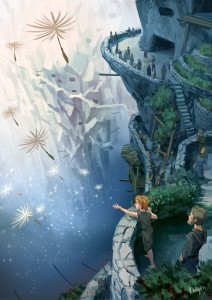
This story owes a great deal to both William S. Burroughs’ Junky (indeed, the protagonist is named Bill in his honor) and Joe R. Lansdale’s Drive-In, a book I found immensely freeing and exhilarating in its sheer WTFery and bravura. If you’ve read A Querulous Flute of Bone, it’s the same world, that of the co-writing project The Fathomless Abyss.
From part of today’s writing:
Bill felt a rush of fear, but a kind that he had never experienced before, something like the fear you feel when someone tells you a frightening story that they believe is true. A terror that was convincing yet somehow dilute. A terror that was not his, somehow.
A fear that was enjoyable.
He realized that it was the creature. That he was feeling its emotions. That if he closed his eyes, he could still see the room like a ghostly overlay across the darkness behind his lids.
He wondered if it experienced the same phenomenon, this double life. He put his hand up and touched it with a fingertip, stroking along the coarse fur that was still damp with eggy fluid. It smelled like newly-split wood, rare and sharp. As he touched it, it shuddered but stayed still, like a woman whose innermost core had been touched, who feared and craved more. At the thought, he grew hard, and he felt it shudder again before it curled tighter around his neck.
He lay there with it around his neck, savoring the mental taste of it, dipping in and out of its perceptions. After a while, his bladder drove him into standing and using the chamber pot beneath his bed. As he pissed, he could feel the creature tasting his sensations in turn.
It made him curious. Settling back onto the bed, he took a syrette from the bedside table, already loaded with honeypain. He injected it in his wrist and lay back to feel the twofold sensation.
First it felt as though the back of his eyes had dissolved, only to be filled with a subtle warmth that flowed out from them, flowing through him until he was only a zone of temperature and sensation, as though he was warm water in a bath, only an outline. But always with that lurking presence perceiving him, keeping him whole. He had loved honeypain for its ability to take him outside himself, but now he realized that it was nothing compared to the creature.
He tried to think at it, to see if it would answer him, but all his thoughts were blurred by the honeypain. He could hear only his blood drumming in his veins, a hard and insistent beat that told him he was alive, as it had before, for sometimes when he was dipped deep in these reveries, he thought himself dead. Now he had that beat but more ““ the creature curled on his chest. Part of him but not part.
After a while he slept.
Enjoy this sample of Cat’s writing and want more of it on a weekly basis, along with insights into process, recipes, photos of Taco Cat, chances to ask Cat (or Taco) questions, discounts on and news of new classes, and more? Support her on Patreon..






